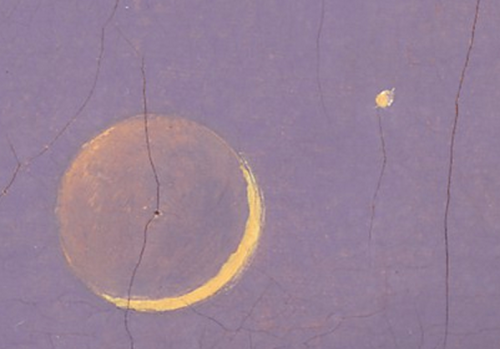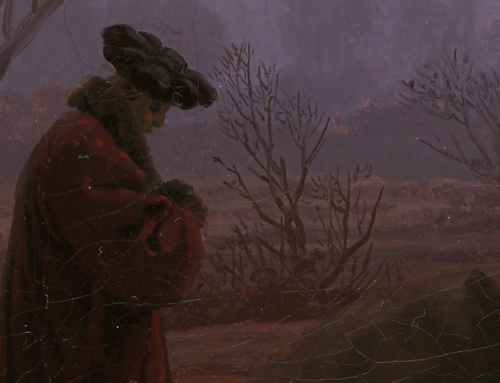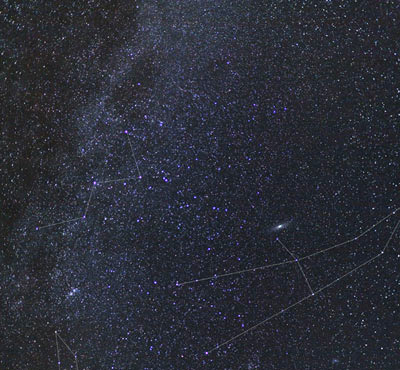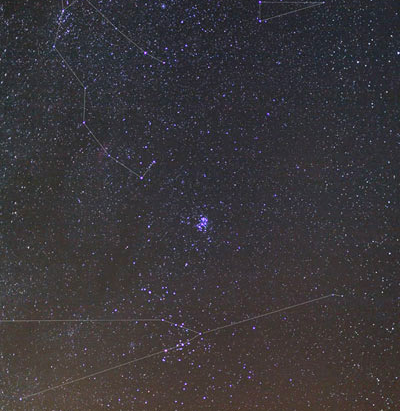



A Walk at Dusk (about 1830-35)
Caspar David Friedrich (German, 1774-1840)
I posted previously about this painting I saw at the Getty last weekend. As someone who loves the sight of a crescent moon, and still more a close conjunction with a bright planet, I really liked this scene, and the contrast Friedrich created between the beautiful event in the sky above and the somber scene depicted below.
Reading up on Friedrich since then, I found his story compelling. His mother died when he was seven, a sister died when he was eight, and then, when he was 13, his younger brother Johann broke through the ice on a frozen lake and drowned before his eyes. At 16 he began his formal training as an artist, and ended up becoming one of the leading painters of the German Romantic period, specializing in landscapes that placed diminished human figures in evocative natural settings.
There was both a figurative and a literal darkness to his work. He frequently experienced episodes that today would probably be diagnosed as major depression. Some lighter scenes and more use of color emerged after Friedrich, at the age of 42, married 25-year-old Caroline Bommer and started his own family. But as time passed his style fell out of favor and his reputation declined, until he and his paintings were viewed as little more than strange and melancholy curiosities. His later life was spent in poverty and obscurity, and his paintings increasingly featured a bent, aged figure: Friedrich himself, contemplating scenes where symbols of death, like the megalithic tomb shown in this painting, were prominent.
A Walk at Dusk does not have an exact date; the Getty placard lists it as “about 1830-35”, those being the last years in which Friedrich was able to work in oils. He suffered a debilitating stroke in 1835 and never fully recovered; during the last five years of his life he created few works, with most of those being smaller paintings and watercolors. My guess is that A Walk at Dusk, along with a number of other works dated 1830-35, went unsold during his lifetime, and only became of interest after his death, at which point Friedrich’s haphazard records made it impossible to fix the dates of the works more precisely.
The placard accompanying the painting at the Getty mentions the new moon, but doesn’t mention the planet alongside it. But as someone who loves planetary conjunctions I noticed it right away. And it made me wonder: Would it be possible to figure out when Friedrich might have seen that conjunction? With desktop planetarium software it’s easy to simulate the sky for any date and location, so earlier today I used a program called Stellarium to look at all the young moons Friedrich might have seen if he’d been walking near Dresden at dusk during the years 1830 to 1835.
I think I may have found it. If Friedrich was depicting an actual sky he’d seen recently, rather than merely inventing a sky, or basing the painting on a sketch he’d made years before, then there’s really only one good candidate: The night of January 6, 1832, when an 11% illuminated moon hung low in the southwest with Jupiter a half-degree above and to the right.
I included enlargements of the painting and a screenshot from Stellarium above, so you can see how closely the painting matches the sky from that date. There were a half-dozen other conjunctions during those years, but nothing that comes close to having the moon and a bright planet in the right position at the right time. But the conjunction of January 6, 1832 is an almost perfect match.
I really like this painting. I like thinking about the deeper themes Friedrich was communicating with it. But I also like the idea that because of his belief in the importance of depicting the beauty of the natural world faithfully, and because of our shared appreciation of the beauty of a close conjunction, I may have been able to tell the precise evening when he saw that sky.
Reposted from http://lies.tumblr.com/post/43629983224.







